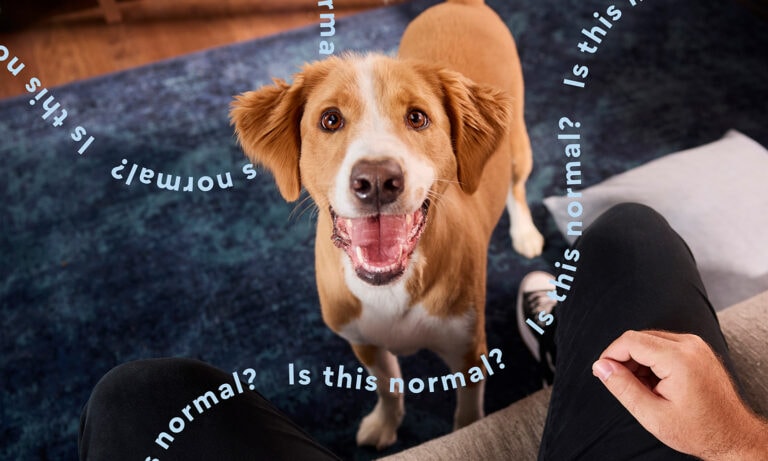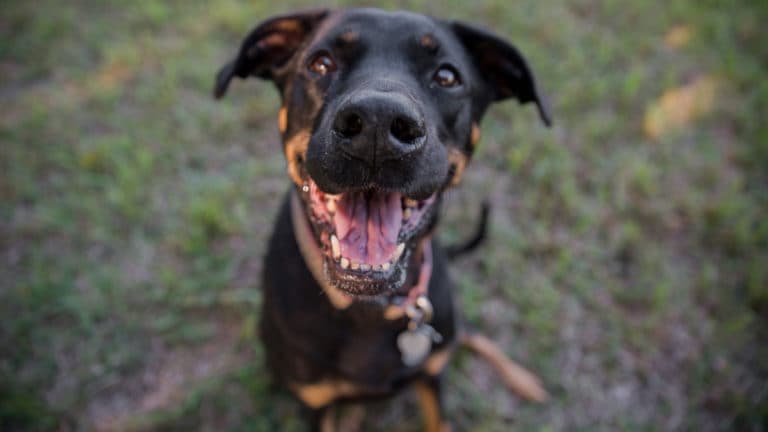We smile when we are happy, but we also smile when we’re nervous, uncomfortable, or trying to figure out a puzzle. A dog tail is similar—subtle variations can change the meaning of the action.
Dogs are masters of non-verbal communication, and their tails play an important role in conveying their emotions. In fact, studies suggest that not only do dogs wag their tails in certain directions for different emotions, but dogs also pay close attention to the asymmetric movement of other dogs’ tails to get a read on new situations.
Here are three reasons your dog is wagging his tail—plus an explanation of what purpose tails serve.
A dog’s tail can say, “I’m happy!”
It’s true that the most common reason why a dog wags her tail is because she’s excited. To determine if this is the case, pay attention to the rest of the dog’s body language. A dog that is content has a relaxed body posture, soft ears and a gentle gaze in addition to a wagging tail. A dog that is excited to play may not only wag her tail furiously—she’ll often bark excitedly, spin in circles, and jump up to paw the air.
A study by Giorgio Vallorigara of the University of Trento in Italy demonstrated that dogs wag their tail to their right side when encountering someone friendly—like their owner. Follow-up studies illustrate that a dog stays relaxed when viewing an image of another dog wagging his tail to the right. A happy wag often moves the entire body in the process!
In fact, your dog’s tail may beat so wildly at mealtimes that that it thumps against the side of his body. Nutritious, delicious dog food, like Tylee’s Beef Recipe Human-Grade Dog Food, only increases the wag rate! And keep his tail wagging with some tasty treats like Halo Liv-A-Littles Grain-Free 100% Chicken Breast Freeze-Dried Treats or Stella & Chewy’s Carnivore Crunch Grass-Fed Beef Recipe Freeze-Dried Dog Treats.
A dog’s tail can say, “I’m anxious!”
“A common mistake many people make is that they see a wagging tail and assume it’s a sign of a friendly dog, [which is] not always the case,” says Michael Schaier, a certified professional dog trainer and owner of Michael’s Pack, a Long Island-based training company focused on positive reinforcement.
A wagging dog tail can mean the dog is anxious. In fact, further research by University of Trento in Italy indicated that dogs wag their tail more to the left when confronted with a threat, such as an unfamiliar, dominant dog. Other body language clues will also indicate nervousness.
For example, if your dog is caught chewing on the side of the couch, he may crouch down, pin his ears back, and wag his tail low and to the left. To the human eye, this looks “guilty,” but your reaction has just made him nervous. Redirect his chewing to an appropriate toy, such as USA Bones & Chews Elk Burr Rope Dog Toy or redirect his energy to a positive outlet, such as training exercise, and reward his effort with dog treats like Primal Turkey Liver Munchies Freeze-Dried Treats.
Dogs in uncomfortable situations often tuck their tail under into a submissive posture that means, “I’m not a threat! Leave me alone!” According to Schaier, this posture is a clear sign of “fear and anxiety.” Alternatively, some dogs will strike a defensive posture, throwing their tail up high while they stand tall, and the hair on their back goes rigid. This body language is also a response to a threatening situation, but the animal is trying to make themselves appear bigger and tougher so the threat will back down. “A stiff, wagging tail is a sign of aggression,” warns Schaier.
A dog’s tail can say, “I’m paying attention!”
A focused dog often holds his tail horizontally or up high as he trains or explores. Again, it’s important to pay attention to the rest of his body language in this situation. If he’s busy trotting about with his nose close to the ground, his stiff tail simply indicates exploration. If he seems agitated and restless with a stiff puppy tail, there may be a threat in your yard—like a wild animal or an unfamiliar person.
The Function of a Dog’s Tail
A dog’s tail is an extension of his spine. It helps center him while he runs, and can also serve as a rudder when he’s swimming! If a dog is sprinting and makes a tight turn, the tail serves as a counterweight to keep him from stumbling. A dog walking along a narrow surface—such as along a curb—will hold his tail stiffly upright to help maintain his balance.
The position of the tail also determines how much scent a dog releases from the anal glands located at the base of the tail. With each wag, the dog’s muscles contract around these glands, which contain pheromones (a communication chemical). While humans usually cannot detect the scent of these pheromones, other dogs easily catch the odor. A dominant dog holding his tail stiff and high releases more scent than a submissive dog that has tucked his tail under, covering the anal glands.
What if a dog has no tail?
A puppy tail typically begins wagging when a dog is 6-7 weeks old. Tail wagging is both an innate and learned behavior that is finely tuned the more dogs interact with each other. Tails are important communication tools.
If a dog’s tail is docked, they’ll still wag the little stump, but it’s obviously much harder for other dogs or humans to read what these movements mean. “One of the biggest problems we incur as trainers are dogs with nub tails or docked tails where it is too difficult to tell,” notes Schaier.
A dog with a docked tail may be more expressive with the rest of his body and more cautious about approaching other unfamiliar dogs for the first time.
By Chewy Editorial
Share:














